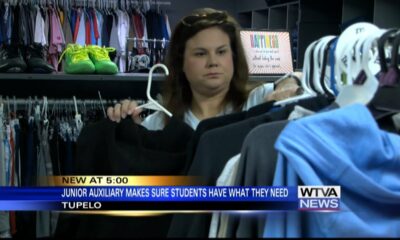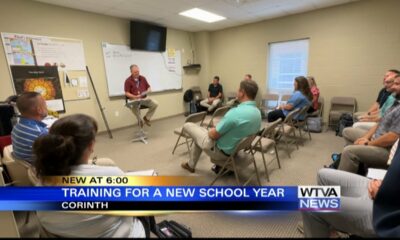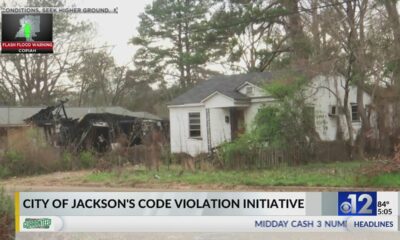Kaiser Health News
California Gov. Newsom Wants Voters to Approve Billions More to Help the Homeless. Will It Help?
Angela Hart
Mon, 26 Feb 2024 10:00:00 +0000
SACRAMENTO, Calif. — California voters will decide March 5 whether to pump billions more dollars into combating the nation's worst homelessness crisis, an investment Democratic Gov. Gavin Newsom argues will finally provide the housing and treatment so badly needed by tens of thousands of homeless people.
Newsom is spearheading Proposition 1, a $6.4 billion bond he says would fund 11,150 new beds and housing units for people living on the streets with untreated mental illness or addiction, and ongoing capacity for 26,700 additional outpatient appointments. It would also alter how $3 billion to $4 billion in existing annual tax funding for mental health services is spent, funneling a hefty portion of it into housing.
Many authorities on mental health and homelessness agree California desperately needs thousands more housing units and treatment beds to successfully attack the growing public health crisis. Health and law enforcement groups have lined up behind the initiative, as have the mayors of the state's major cities.
Homelessness statistics in California have risen a staggering 20% since Newsom took office in 2019, to more than 180,000 people — 68% of them on the streets and not in shelters. The numbers are growing despite Newsom's unprecedented investment of more than $20 billion in homelessness programs, plus billions more for health and social services.
Yet many of the front-line workers implementing Newsom's initiatives fear that Proposition 1 would simply pour more money into a broken homelessness response system that is largely failing to house those in need.
Rather than focus on getting homeless people into mental health and addiction programs — and ultimately into housing — many caseworkers say they waste precious time and taxpayer dollars searching for their homeless clients after encampments have been cleared by state and local officials, a policy Newsom has encouraged, not only for the safety of homeless people but for those in surrounding neighborhoods.
Once they locate their clients, advocates must help them — often repeatedly — obtain food, clothing, and medication refills, and replace official government documents like birth certificates and IDs. “You can't get housing without that stuff,” said Afton Francik, an outreach worker with the Sacramento-based nonprofit Hope Cooperative, which is implementing several of Newsom's homelessness and mental health initiatives.
Perhaps the biggest challenge they face, outreach workers and case managers say, is rebuilding the trust that took time to establish — and which they say is essential to getting people into treatment and housing.
“It makes it so much harder to even find people or help them get into housing because you have to go back and repeat that work you already did,” Francik said.
Newsom says California has placed at least 71,000 people indoors — either in permanent or temporary housing — since he took office in 2019. State money flows to cities and counties, which have opened at least 15,000 housing units and 2,485 residential treatment beds, plus additional outpatient capacity, during his tenure.
Newsom has also revamped health programs to get people off the streets, including a massive $12 billion transformation of the state Medicaid health insurance program that provides some patients with housing and one-on-one case management services.
As he promotes Proposition 1, Newsom is calling for stricter enforcement, saying he feels a deep responsibility to keep California's streets clean and safe, and to respond to growing neighborhood concerns about trash, mental illness, crime, and drugs. He has acknowledged that sweeps can traumatize homeless people but argues that local officials who receive state money to clear encampments are supposed to find shelter or treatment for those displaced.
Sacramento County Sheriff Jim Cooper, who supports Proposition 1, said sweeps are sometimes necessary for public health and safety.
“This is a huge drain on public resources and emergency services,” Cooper said. “Drugs are everywhere. There is so much mental illness. We've got to get these folks the help and treatment they need.”
But critics of the sweeps argue that it's inhumane to forcibly move people without providing shelter or housing. “We're seeing a ton of enforcement, but there's literally nowhere to put people,” said Crystal Sanchez, president of the Sacramento Homeless Union.
Newsom acknowledged the state doesn't have enough housing for everyone who needs it, and that Proposition 1 is part of the solution. The measure would expand his existing housing and treatment programs, which do not trigger the land use and environmental reviews that often delay or kill new projects.
“We are in a unique position to take what we have been promoting — these promises — and make them real,” Newsom said in January.
Like all of Newsom's homeless housing initiatives, Proposition 1 would rely on outreach teams and caseworkers to help homeless people obtain services and housing.
But in boots-on-the-ground interviews from rural Northern California to San Diego, such workers said it would be difficult to get more people into housing if they must continue picking up the pieces after encampment clearings — a policy the U.S. Supreme Court will scrutinize in April.
The question the court will consider is whether to allow criminal or civil penalties against homeless people living outdoors if no shelter or housing is available. Newsom said in an amicus brief that cities and counties should be allowed to clear encampments, signaling he has no plans to retreat from the policy.
“When encampments are being cleared by law enforcement, it totally upends people's lives and violates that trust in a way that they're going to be more resistant to help,” said Hannah Wesolowski, chief advocacy officer for the National Alliance on Mental Illness, whose California chapter supports the ballot initiative. “If someone has a mental illness and is unhoused, trust is the most important thing in trying to engage them in treatment and actually getting them into housing.”
Take Samuel Buckles, a longtime Sacramento resident who said he struggles with mental health and is addicted to fentanyl. Buckles, 53, lost his home in a fire and then his job early in the covid-19 pandemic. Since then, he has worked odd jobs as a handyman and purchased a recreational vehicle that he parked around Sacramento and called home.
When law enforcement officials cleared his camp in early February, they confiscated his RV because he had allowed the registration to lapse. He lost his birth certificate and Social Security card, all his medications for diabetes and high blood pressure, his extra clothing, and a fridge packed with groceries he'd recently purchased with his food stamp benefits.
“That was my home and everything I had in the world,” Buckles said on a cold February morning from his new form of shelter: a tent donated by outreach workers.
It was the first time in years he said he had truly felt homeless.
In mid-February, law enforcement cleared the encampment he had relocated to, forcing him to move again. Feeling despondent, he said he had given up on the promise of housing. “Please make this pain stop. I don't know how much more I can take,” he said.
Buckles was able to grab a few possessions from his RV after it was confiscated, but replacing the documents he needs for housing may take months and repeat visits by outreach workers, said Greg Stupplebeen, an outreach manager with Hope Cooperative.
Even if Buckles had his paperwork in order, “there's nowhere to put anybody right now,” Stupplebeen told him.
This article was produced by KFF Health News, which publishes California Healthline, an editorially independent service of the California Health Care Foundation.
——————————
By: Angela Hart
Title: California Gov. Newsom Wants Voters to Approve Billions More to Help the Homeless. Will It Help?
Sourced From: kffhealthnews.org/news/article/california-homeless-newsom-billions-ballot-initiative/
Published Date: Mon, 26 Feb 2024 10:00:00 +0000
Did you miss our previous article…
https://www.biloxinewsevents.com/pregnancy-care-was-always-lacking-in-jails-it-could-get-worse/
Kaiser Health News
Union With Labor Dispute of Its Own Threatens to Cut Off Workers’ Health Benefits
Phil Galewitz, KFF Health News
Fri, 26 Jul 2024 09:00:00 +0000
The National Education Association, the nation's largest union, is threatening to cut off health insurance to about 300 Washington, D.C.-based workers on Aug. 1 in an effort to end a bitter contract dispute.
It's a tactic some private employers have used as leverage against unionized workers that has drawn scrutiny from congressional Democrats and is prohibited for state employers in California. Experts on labor law say they've never seen a union make the move against its own workers.
“This is like a man-bites-dog situation where the union is now in a position as the employer,” said Paul Clark, a professor of labor and employment relations at Penn State University. “It's not a good look for a union.”
NEA workers with pressing health needs are worried but say they won't fold. Joye Mercer Barksdale, a writer on the NEA's government relations team, said she needs coverage for a medical procedure to address atrial fibrillation, a cardiac disorder. “This is insane for the NEA to use our health benefits as a bargaining chip,” she said.
But Barksdale said the threat isn't enough to force her to agree to an unacceptable contract. “I am not ready to give in,” she said.
The NEA Staff Organization, the union representing workers at the NEA's headquarters, launched a strike on July 5 in Philadelphia, during the union's annual delegate assembly. It was its second walkout this summer as the two parties negotiate a new contract, navigating sticking points such as wages and remote work.
In response, the NEA ended the conference early. President Joe Biden was supposed to speak at the event but withdrew, refusing to cross the picket line. The NEA on July 24 endorsed Kamala Harris for president.
On July 8, the day after the conference had been scheduled to end, the NEA locked out workers. In a letter the day before, the NEA informed its unionized workers that they would not be paid, effective immediately, and their health benefits would expire at the end of July unless a new deal were reached.
“NEA cannot allow NEASO to act again in a way that will bring such lasting harm to our members and our organization,” Kim Anderson, the NEA's executive director, wrote in the letter, obtained by KFF Health News. “We are, and have always been, committed both to our union values and to the importance of conducting ourselves as a model employer.”
Democrats in Congress, including Sens. Sherrod Brown of Ohio and Bob Casey of Pennsylvania, introduced legislation last year to protect striking workers from losing their health benefits, after several large companies, including General Motors, John Deere, RTX (formerly Raytheon Technologies), and the maker of Kellogg's cereals, threatened to or did cut off coverage during labor disputes.
“Workers shouldn't have to choose between their family's health and a fair contract,” Brown said in a statement to KFF Health News.
The legislation was endorsed by large labor unions including the Service Employees International Union and United Steelworkers, according to a press release from Brown's office. The NEA wasn't among them.
“This tactic is immoral, and it should be illegal,” United Steelworkers' president at the time, Thomas Conway, said in the release.
Officials at the NEA, which represents teachers and other administrators, declined an interview request. In a statement, the organization's president, Becky Pringle, said “we are making every effort to reach an agreement as quickly as possible” with its staff union.
“As union leaders who have been on strike, we recognize the significance and impact of these important decisions on a personal and family level. We truly value our employees and look forward to continued collaboration with NEASO to develop a new contract that benefits us all,” she said.
Kate Hilts, a digital strategist who works for the NEA, said she fears losing her coverage will leave her unable to afford treatment for a rare autoimmune disease that attacks her kidneys. Her next treatment was slated for August.
“I wake up every day and can't believe this is happening,” she said. “You would expect this from an employer that is antiworker or has a terrible labor record, but I am totally flabbergasted that a labor union would do this that bills itself as pro-worker, pro-family, pro-education, and pro-children.”
The NEA staff union has filed multiple charges with the National Labor Relations Board this year, including allegations that the NEA withheld holiday overtime pay and failed to provide information on the outsourcing of millions of dollars in bargaining unit work.
California is one of the only states that protect striking workers from losing health coverage. The state legislature passed a law in 2021 that blocks the tactic from being used against public employees and another law in 2022 that allows any striking workers who lose their insurance to immediately get heavily discounted coverage through the state's Affordable Care Act marketplace.
If they remain locked out, the NEA workers would be eligible for coverage under COBRA, a federal program that allows people who are fired or laid off to maintain their employer-sponsored insurance for 18 months.
But the coverage can be a financial hardship, as individuals often must pay the entire cost of their insurance premiums, plus a 2% administrative fee.
Another option for workers would be coverage through the Affordable Care Act marketplace, though that also could be costly. And it may be unclear how soon that coverage would begin or whether insurers would cover their existing doctors.
“I'm hoping the NEA will be so ashamed of what they are doing that, at the very least, they will not take away our health benefits,” Barksdale said.
——————————
By: Phil Galewitz, KFF Health News
Title: Union With Labor Dispute of Its Own Threatens to Cut Off Workers' Health Benefits
Sourced From: kffhealthnews.org/news/article/nea-national-education-association-union-threatens-health-insurance-benefit-lockout/
Published Date: Fri, 26 Jul 2024 09:00:00 +0000
Did you miss our previous article…
https://www.biloxinewsevents.com/the-cdcs-test-for-bird-flu-works-but-it-has-issues/
Kaiser Health News
The CDC’s Test for Bird Flu Works, but It Has Issues
Arthur Allen and Amy Maxmen
Fri, 26 Jul 2024 09:00:00 +0000
The Centers for Disease Control and Prevention says a glitch in its bird flu test hasn't harmed the agency's outbreak response. But it has ignited scrutiny of its go-it-alone approach in testing for emerging pathogens.
The agency has quietly worked since April to resolve a nagging issue with the test it developed, even as the virus swept through dairy farms and chicken houses across the country and infected at least 13 farmworkers this year.
At a congressional hearing July 23, Rep. Brett Guthrie (R-Ky.) asked about the issue. “Boy, that rings of 2020,” he said, referring to when the nation was caught off guard by the covid-19 pandemic, in part because of dysfunctional tests made by the CDC. Demetre Daskalakis, director of the CDC's National Center for Immunization and Respiratory Diseases, responded that the agency rapidly developed a workaround that makes its bird flu test reliable.
“The tests are 100% usable,” he later told KFF Health News, adding that the FDA studied the tests and came to the same conclusion. The imperfect tests, which have a faulty element that sometimes requires testing a sample again, will be replaced soon. He added, “We have made sure that we're offering a high-quality product.”
Still, some researchers were unnerved by the news coming four months after the government declared a worrisome bird flu outbreak among cattle. The CDC's test is the only one available for clinical use. Some researchers say its flaws, though manageable, underscore the risk of relying on a single entity for testing.
The problem came to light in April as the agency prepared to distribute its test to about 100 public health labs around the country. CDC officials detected the issue through a quality control system put in place after the covid test catastrophe of 2020.
Daskalakis said the CDC's original test design was fine, but a flaw emerged when a company contracted by the agency manufactured the tests in bulk. In these tests, one of two components that recognize proteins called H5 in the H5N1 bird flu virus was unreliable, eliminating an important safeguard. By targeting the same protein twice, tests have a built-in backup in case one part fails.
The agency developed a fix to ensure a reliable result: If only one of the two parts detected H5, the test was considered inconclusive and would be run again. With the FDA's blessing, the CDC distributed the tests — with workaround instructions — to public health labs.
Kelly Wroblewski, director of infectious diseases at the Association of Public Health Laboratories, said the results of the tests have not been ambiguous, and there is no need to discard the tests.
Still, the agency has asked a different manufacturer to remake the faulty component so that 1.2 million improved tests will be available soon, Daskalakis said. Some of the updated tests are already in stock at the CDC, but the FDA hasn't yet signed off on their use. Daskalakis declined to name the manufacturers.
Meanwhile, the outbreak has grown. Farmworkers continue to lack information about the virus and gear to protect them from it. Rural clinics may miss cases if they don't catch a person's connection to a farm and notify health officials rather than their usual diagnostic testing laboratories.
Those clinical labs remain unauthorized to test for the bird flu. Several of those labs have spent months working through analyses and red tape so that they can run the CDC's tests. As part of the licensing process, the CDC alerted them to the workaround with the current test, too.
But outside select circles, the news was largely overlooked. “I'm totally surprised by this,” Alex Greninger, assistant director of the University of Washington Clinical Virology Laboratory, told KFF Health News this week. Greninger's lab is developing its own test and has been trying to obtain CDC test kits to evaluate.
“It's not a red alarm,” he said, but he's worried that as the CDC and the FDA spend months developing and evaluating an updated test, the only one available relies on a single component. If the genetic code underlying that fragment of the H5 protein mutates, the test could give false results.
It's not uncommon for academic and commercial diagnostic labs to make mistakes and catch them during quality control checks, as the CDC did. Still, this isn't the agency's first mishap. In 2016, well before the covid debacle, CDC officials for months directed public health labs to use a Zika test that failed about a third of the time.
The CDC caught and worked to remediate the situation far more quickly and effectively in this case. Nonetheless, the mishap raises concern. Michael Mina, chief science officer of the telemedicine company eMed.com, said diagnostic companies may be better suited to the task.
“It's a reminder that CDC is not a robust manufacturer of tests” and lacks the resources that industry can marshal for their production, Mina said. “We do not ask CDC to make vaccines and pharmaceuticals, and we do not ask the Pentagon to manufacture missiles.”
The CDC has licensed its updated test design to at least seven clinical diagnostic labs. Such labs are the foundation of testing in the U.S. But none have FDA clearance to use them.
Diagnostic labs are developing their own tests, too. But that has been slow-going. One reason is the lack of guaranteed sales. Another is regulatory uncertainty. Recent FDA guidance could make it harder for nongovernmental laboratories to issue new tests in the early phase of pandemics, said Susan Van Meter, president of the American Clinical Laboratory Association, in a July 1 letter to the FDA.
Transparency is also critical, scientists said. Benjamin Pinsky, medical director of the clinical virology laboratory at Stanford University, said as a public agency the CDC should make its protocol — its recipe for making the test — easily accessible online.
The World Health Organization does so for its bird flu tests, and with that information in hand, Pinsky's lab has developed an H5 bird flu test suited to the strain circulating this year in the U.S. The lab published its approach this month but doesn't have FDA authorization for its broad use.
The CDC's test recipe is available in a published patent, Daskalakis said.
“We have made sure that tests are out there, and that they work,” he added.
As the CDC came under fire at the July 23 congressional hearing, Daniel Jernigan, director of the CDC's National Center for Emerging and Zoonotic Infectious Diseases, noted that testing is just one tool. The agency needs money for another promising area — looking for the virus in wastewater. Its current program uses supplemental funds, he said: “It is not in the current budget and will go away without additional funding.”
——————————
By: Arthur Allen and Amy Maxmen
Title: The CDC's Test for Bird Flu Works, but It Has Issues
Sourced From: kffhealthnews.org/news/article/bird-flu-test-cdc-flaws/
Published Date: Fri, 26 Jul 2024 09:00:00 +0000
Kaiser Health News
KFF Health News’ ‘What the Health?’: Harris in the Spotlight
Thu, 25 Jul 2024 18:45:00 +0000
The Host
Julie Rovner
KFF Health News
Julie Rovner is chief Washington correspondent and host of KFF Health News' weekly health policy news podcast, “What the Health?” A noted expert on health policy issues, Julie is the author of the critically praised reference book “Health Care Politics and Policy A to Z,” now in its third edition.
As Vice President Kamala Harris appears poised to become the Democratic Party's presidential nominee, health policy in general and reproductive health issues in particular are likely to have a higher profile. Harris has long been the Biden administration's point person on abortion rights and reproductive health and was active on other health issues while serving as California's attorney general.
Meanwhile, Congress is back for a brief session between presidential conventions, but efforts in the GOP-led House to pass the annual spending bills, due by Oct. 1, have run into the usual roadblocks over abortion-related issues.
This week's panelists are Julie Rovner of KFF Health News, Stephanie Armour of KFF Health News, Rachel Cohrs Zhang of Stat, and Alice Miranda Ollstein of Politico.
Panelists
Stephanie Armour
KFF Health News
Rachel Cohrs Zhang
Stat News
Alice Miranda Ollstein
Politico
Among the takeaways from this week's episode:
- President Joe Biden's decision to drop out of the presidential race has turned attention to his likely successor on the Democratic ticket, Vice President Kamala Harris. At this late hour in the campaign, she is expected to adopt Biden's health policies, though many anticipate she'll take a firmer stance on restoring Roe v. Wade. And while abortion rights supporters are enthusiastic about Harris' candidacy, opponents are eager to frame her views as extreme.
- As he transitions from incumbent candidate to outgoing president, Biden is working to frame his legacy, including on health policy. The president has expressed pride that his signature domestic achievement, the Inflation Reduction Act, took on the pharmaceutical industry, including by forcing the makers of the most expensive drugs into negotiations with Medicare. Yet, as with the Affordable Care Act's delayed implementation and results, most Americans have yet to see the IRA's potential effect on drug prices.
- Lawmakers continue to be hung up on federal government spending, leaving appropriations work undone as they prepare to leave for summer recess. Fights over abortion are, once again, gumming up the works.
- In abortion news, Iowa's six-week limit is scheduled to take effect next week, causing rippling problems of abortion access throughout the region. In Louisiana, which added the two drugs used in medication abortions to its list of controlled substances, doctors are having difficulty using the pills for other indications. And doctors who oppose abortion are pushing higher-risk procedures, like cesarean sections, in lieu of pregnancy termination when the mother's life is in danger — as states with strict bans, like Texas and Louisiana, are reporting a rise in the use of surgeries, including hysterectomies, to end pregnancies.
- The Government Accountability Office reports that many states incorrectly removed hundreds of thousands of eligible people from the Medicaid rolls during the “unwinding” of the covid-19 public health emergency's coverage protections. The Biden administration has been reluctant to call out those states publicly in an attempt to keep the process as apolitical as possible.
Also this week, Rovner interviews Anthony Wright, the new executive director of the consumer health advocacy group Families USA. Wright spent the past two decades in California, working with, among others, now-Vice President Kamala Harris on various health issues.
Plus, for “extra credit,” the panelists suggest health policy stories they read this week that they think you should read, too:
Julie Rovner: NPR's “A Study Finds That Dogs Can Smell Your Stress — And Make Decisions Accordingly,” by Rachel Treisman.
Alice Miranda Ollstein: Stat's “A Pricey Gilead HIV Drug Could Be Made for Dramatically Less Than the Company Charges,” by Ed Silverman, and Politico's “Federal HIV Program Set To Wind Down,” by Alice Miranda Ollstein and David Lim.
Stephanie Armour: Vox's “Free Medical School Won't Solve the Doctor Shortage,” by Dylan Scott.
Rachel Cohrs Zhang: Stat's “How UnitedHealth Harnesses Its Physician Empire To Squeeze Profits out of Patients,” by Bob Herman, Tara Bannow, Casey Ross, and Lizzy Lawrence.
Also mentioned on this week's podcast:
- States Newsroom's “Anti-Abortion Researchers Back Riskier Procedures When Pregnancy Termination Is Needed, Experts Say,” by Sofia Resnick.
- KFF Health News' “Louisiana Reclassifies Drugs Used in Abortions as Controlled Dangerous Substances,” by Rosemary Westwood, WWNO.
- The New York Times' “Biden and Georgia Are Waging a Fight Over Medicaid and the Future of Obamacare,” by Noah Weiland.
Credits
Francis Ying
Audio producer
Emmarie Huetteman
Editor
To hear all our podcasts, click here.
And subscribe to KFF Health News' “What the Health?” on Spotify, Apple Podcasts, Pocket Casts, or wherever you listen to podcasts.
KFF Health News is a national newsroom that produces in-depth journalism about health issues and is one of the core operating programs at KFF—an independent source of health policy research, polling, and journalism. Learn more about KFF.
USE OUR CONTENT
This story can be republished for free (details).
——————————
Title: KFF Health News' ‘What the Health?': Harris in the Spotlight
Sourced From: kffhealthnews.org/news/podcast/what-the-health-357-kamala-harris-campaign-health-policy-july-25-2024/
Published Date: Thu, 25 Jul 2024 18:45:00 +0000
Did you miss our previous article…
https://www.biloxinewsevents.com/montana-looks-to-become-latest-state-to-boost-nonprofit-hospital-oversight/
-
Mississippi News5 days ago
Columbus woman accused of nearly running over law enforcement – Home – WCBI TV
-
Mississippi News6 days ago
OCSD warns of a scam circling the area
-
Mississippi News4 days ago
Suspect wanted after man killed in South Jackson
-
Mississippi News6 days ago
Fulton teen dies following a traffic accident in Alabama
-
Mississippi News6 days ago
Local hair salon gives away free bookbags
-
Mississippi News6 days ago
Starkville teen faces list of charges in connection to auto burglaries
-
Our Mississippi Home6 days ago
Fiddler Crabs Love to Wave
-
Mississippi Today2 days ago
Neuroscientist becomes the seventh person to plead guilty in welfare scandal
































